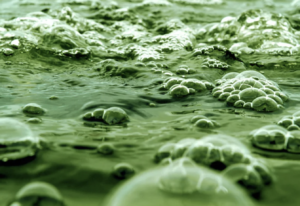 High oil prices, competing demands between foods and other biofuel sources, and the world food crisis, have ignited interest in algaculture (farming algae) for making vegetable oil, biodiesel, bioethanol, biogasoline, biomethanol, biobutanol, and other biofuels, using land that is not suitable for agriculture. Algae hold enormous potential to provide a non-food, high-yield, non-arable land use source of biodiesel, ethanol, and hydrogen fuels. Microalgae are the fastest growing photosynthesizing organism capable of completing an entire growing cycle every few days. Up to 50% of algae’s weight is comprised of oil, compared with, for example, oil palm which yields just about 20% of its weight in oil.
High oil prices, competing demands between foods and other biofuel sources, and the world food crisis, have ignited interest in algaculture (farming algae) for making vegetable oil, biodiesel, bioethanol, biogasoline, biomethanol, biobutanol, and other biofuels, using land that is not suitable for agriculture. Algae hold enormous potential to provide a non-food, high-yield, non-arable land use source of biodiesel, ethanol, and hydrogen fuels. Microalgae are the fastest growing photosynthesizing organism capable of completing an entire growing cycle every few days. Up to 50% of algae’s weight is comprised of oil, compared with, for example, oil palm which yields just about 20% of its weight in oil.
Algaculture (farming of algae) can be a route to making vegetable oils, biodiesel, bioethanol, and other biofuels. Microalgae are one-celled, photosynthetic microorganisms that are abundant in freshwater, brackish water, and marine environments everywhere on earth. The potential for commercial algae production is expected to come from growth in translucent tubes or containers called photobioreactors or open ocean algae bloom harvesting. The other advantages of algal systems include:
- carbon capture from smokestacks to increase algae growth rates
- processing of algae biomass through gasification to create syngas
- growing carbohydrate-rich algae strains for cellulosic ethanol
- using waste streams from municipalities as water sources
Algae have certain qualities that make the organism an attractive option for biodiesel production. Unlike corn-based biodiesel which competes with food crops for land resources, algae-based production methods, such as algae ponds or photobioreactors, would “complement, rather than compete” with other biomass-based fuels. Unlike corn or other biodiesel crops, algae do not require significant inputs of carbon-intensive fertilizers. Some algae species can even grow in waters that contain a large amount of salt, which means that algae-based fuel production need not place a large burden on freshwater supplies.
